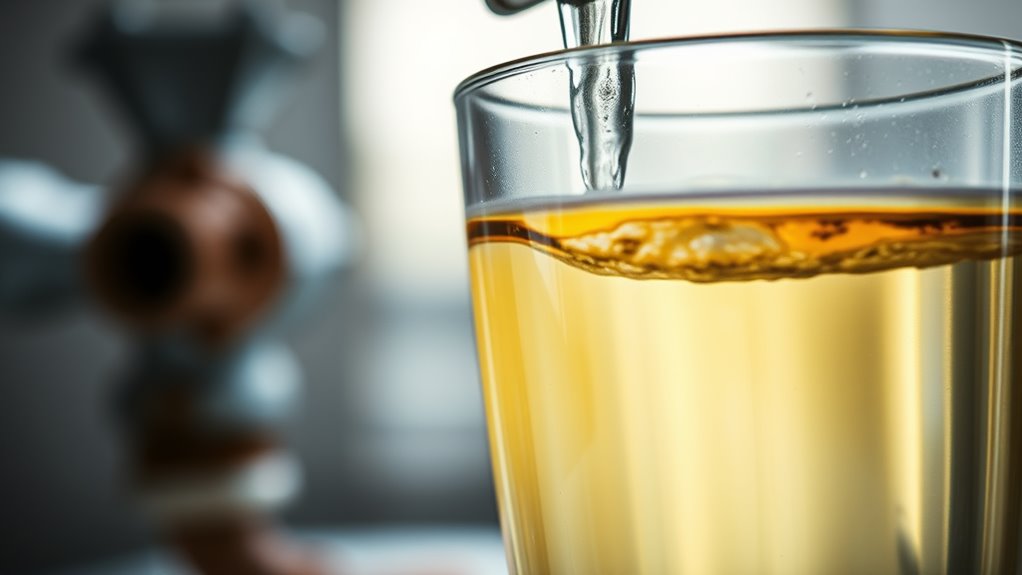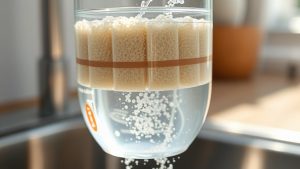
Yellow water in your home can come from several sources. Sediment buildup in your water heater or pipes may cause discoloration. Corroded galvanized steel or iron pipes can introduce rust, while high iron and manganese levels, often from well water, lead to yellow or orange hues. Construction debris and chemical contamination, such as corroded anode rods or high chlorine levels, can also be factors. There's more to uncover about these issues and how to resolve them.
If you've noticed yellow water in your home, it's important to identify the underlying causes to restore your water quality. One common reason for this discoloration is sediment and mineral buildup. Over time, sediments like calcium and magnesium can accumulate in your water heater, leading to yellow hot water. Additionally, mineral deposits in your pipes can cause corrosion and discoloration. To combat this, regularly flushing your water heater and pipes can help remove sediment. Consistent maintenance is crucial to prevent sediment from affecting your water quality, as excessive mineral levels may originate from your water source itself. Yellow water is a common issue for homeowners.
Corrosion of pipes is another potential culprit. If your plumbing system includes galvanized steel or iron pipes, rust can cause yellow water. Although rust is generally safe, it can affect both the taste of your water and the functionality of your appliances. If you experience low water pressure or leaks, these may indicate corroded pipes. Older plumbing systems are particularly susceptible to corrosion, so upgrading to more durable materials like copper or PEX can resolve the issue.
Corroded pipes can lead to yellow water, impacting taste and appliance function, especially in older plumbing systems.
Iron and manganese are also significant contributors to yellow or orange water, particularly in homes relying on well water. Iron may accumulate in your pipes or be introduced during maintenance by your water utility. Manganese often accompanies iron, causing different discoloration patterns. In some cases, iron-related bacteria can contribute to this yellow water as well. To effectively remove iron and manganese, consider using oxidizing filters designed for this purpose.
If your home has undergone recent construction, debris from the building process could be affecting your water quality. Particulates like dirt and sand can enter plumbing systems, leading to yellow water. It's important to flush your system thoroughly after any construction work. Sediment may settle in your water heater, so regular checks are necessary to maintain clean plumbing post-construction.
Contamination from water heater parts can also be a factor. Corroded anode rods can release iron into your water supply, while failing dip tubes may introduce plastic pieces. If you suspect part failures, a professional assessment is advisable. Regular inspections can prevent these issues, making sure that replacement parts are correctly sized and installed.
Bacterial and organic contaminants may also lead to yellowish water. Iron-related bacteria can cause discoloration and odors, while chlorine mixing with organic matter can exacerbate these issues. Organic matter, such as leaves, can also contribute to yellow water in surface water sources. Disinfecting your system with chlorine can eliminate bacteria, and regular testing can help identify bacterial contamination early.
Lastly, high chlorine levels and chemical treatments might be responsible for yellow water. Excess chlorine can mix with organics, causing discoloration, while bromine used in water treatment can have similar effects. If iron salt treatments aren't properly maintained, they can also lead to yellow water. Regular service and water testing are important to avoid these complications, and adjusting or removing chemical treatments may resolve the yellow water problem. By addressing these potential causes, you can restore and maintain the quality of your home's water supply.
Conclusion
In conclusion, yellow water in your home can stem from rust, sediment, or excess minerals. Think of it like an old car with a rusty engine; it needs attention to run smoothly. Regular maintenance and timely inspections can help you identify and address these issues before they escalate. By staying proactive, you can guarantee your water remains clear and safe, enhancing both your health and your home's value. Don't wait for a breakdown—act now to keep your water pristine.



